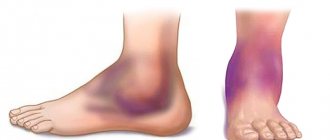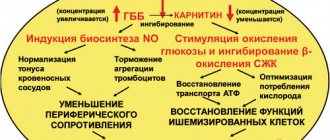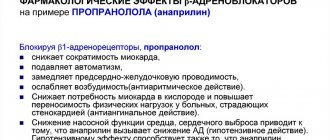We all need protection to one degree or another. External and internal. The body and mind are quite fragile and can be strengthened and supported in different ways. Even with medication.
If a person experiences negative effects (stress, shock, ischemia, intoxication, cerebrovascular accident, etc.), then the doctor may prescribe Mexidol.
Mexidol is a good helper in the fight against stress
Composition and release form
Active ingredient: ethylmethylhydroxypyridine succinate – 50 mg. Excipients: sodium metabisulfite – 0.4 mg; water for injections up to 1 ml. Solution for intravenous and intramuscular administration 50 mg/ml in colorless or light-protective glass ampoules with a blue break point or a white break point and three marking rings (top - yellow, middle - white, bottom - red) 2 ml or 5 ml . 5 ampoules in a blister pack. 1 or 2 blister packs along with instructions for medical use in a cardboard pack. 4, 10 or 20 blister packs along with instructions for medical use in a box of cardboard (for hospitals).
Analogs
The pharmaceutical market offers not only Mexidol, but also its analogues. The drugs differ in the main substance (although the synonyms of Mexidol still contain the same ethylmethylhydroxypyridine succinate), auxiliary components, manufacturers, and the quality of purification of the raw materials used. That is why, after consulting a doctor, you can select medications in pharmacies that are similar in their therapeutic effect to Mexidol tablets, but are suitable for a specific clinical picture.
Replacement of the drug with an analogue must be agreed with the attending physician
Mexidol analogue tablets include:
- Medomexy;
- Mexiprim;
- Mexidant;
- Mexipridol;
- Mexicofin;
- Neurox;
- Cerecard.
Analogues of Mexidol injections
In terms of therapeutic effect, the following drugs are similar to the solution:
- Medomexy;
- Armadin;
- Mexico;
- Astrox;
- Mexipridol;
- Mexiprim.
The therapeutic effect can be achieved by other active substances. But not always analogues in effect can ideally replace the drug chosen by the doctor, so replacement is possible only after consultation.
Thus, the following medications are considered analogous in effect:
- Kaviton (active ingredient - vinpocetine) improves metabolism in brain cells, helps improve blood circulation;
- Nootropil (active ingredient - piracetam) stimulates brain activity;
- Glycine (active ingredient - glycine) improves processes in the brain;
- Cytoflavin (active ingredient - succinic acid) stimulates brain activity, improves thought processes, etc.
Mexidol or Actovegin?
Often those who take Mexidol are faced with a choice between it and Actovegin. What's better? The drugs have similar uses and are often prescribed together. Both act on the central nervous system, eliminate hypoxia, restore metabolism and affect the circulatory system. But Mexidol has broader pharmacological properties, and it is used in most cases. Allergic reactions to Actovegin are more common, but it can be taken by pregnant women. Also, unlike Mexidol, Actovegin is used for disorders in peripheral vessels, and to treat the consequences of such disorders - trophic ulcers and angiopathy. As a result, the decision to prefer one of the drugs or take them together falls on the shoulders of the doctor.
pharmachologic effect
Antioxidant agent. Means for the correction of disorders in alcoholism, toxic and drug addiction.
Pharmacokinetics
With intramuscular administration, it is determined in the blood plasma for 4 hours after administration. The time to reach the maximum concentration Tmax is 0.45-0.5 hours. Cmax when administering a dose of 400-500 mg is 3.5-4.0 μg/ml. Mexidol quickly passes from the bloodstream into organs and tissues and is quickly eliminated from the body. The drug retention time (MRT) is 0.7-1.3 hours. The drug is excreted mainly in the urine, mainly in glucurone-conjugated form and in small quantities unchanged.
Pharmacodynamics
It has antihypoxic, membrane-protective, nootropic, anticonvulsant, anxiolytic effects, and increases the body's resistance to stress.
The drug increases the body's resistance to the effects of major damaging factors, to oxygen-dependent pathological conditions (shock, hypoxia and ischemia, cerebrovascular accident, intoxication with alcohol and antipsychotic drugs (neuroleptics)). Mexidol improves cerebral metabolism and blood supply to the brain, improves microcirculation and rheological properties of blood, and reduces platelet aggregation. Stabilizes the membrane structures of blood cells (erythrocytes and platelets) during hemolysis. It has a hypolipidemic effect, reduces the level of total cholesterol and LDL. Reduces enzymatic toxemia and endogenous intoxication in acute pancreatitis. The mechanism of action of Mexidol is due to its antihypoxic, antioxidant and membrane protective effects. It inhibits the processes of lipid peroxidation, increases the activity of superoxide dismutase, increases the lipid-protein ratio, reduces membrane viscosity, and increases its fluidity. Modulates the activity of membrane-bound enzymes (calcium-independent phosphodiesterase, adenylate cyclase, acetylcholinesterase), receptor complexes (benzodiazepine, GABA, acetylcholine), which enhances their ability to bind to ligands, helps preserve the structural and functional organization of biomembranes, transport of neurotransmitters and improve synaptic transmission.
Mexidol increases dopamine levels in the brain. Causes an increase in the compensatory activity of aerobic glycolysis and a decrease in the degree of inhibition of oxidative processes in the Krebs cycle under hypoxic conditions, with an increase in the content of ATP, creatine phosphate and activation of the energy-synthesizing functions of mitochondria, stabilization of cell membranes. Mexidol normalizes metabolic processes in the ischemic myocardium, reduces the necrosis zone, restores and improves the electrical activity and contractility of the myocardium, and also increases coronary blood flow in the ischemic zone, reduces the consequences of reperfusion syndrome in acute coronary insufficiency. Increases the antianginal activity of nitro drugs. Mexidol promotes the preservation of retinal ganglion cells and optic nerve fibers during progressive neuropathy, the causes of which are chronic ischemia and hypoxia. Improves the functional activity of the retina and optic nerve, increasing visual acuity.
Interaction with other drugs
Mexidol has proven itself to be a drug that is highly compatible with other medications, including those used to treat somatic diseases. But it is worth noting that Mexidol can enhance the effect of benzodiazepines, carbamazepine and drugs for the treatment of Parkinson's disease, analgesics, tranquilizers, neuroleptics and antidepressants, as well as substances with hypnotics and anticonvulsants. This allows you to reduce their doses and remove most side effects.
Mexidol reduces the toxicity of ethyl alcohol. This beneficial property is used in the treatment of alcohol withdrawal syndrome.
Mexidol and alcohol
As mentioned above, Mexidol is used as therapy for getting rid of alcohol addiction. The drug reduces the toxic effect of alcohol and removes it from the body. But this does not mean that you can drink alcohol while taking Mexidol. The active substance Mexidol, penetrating into the tissues of the liver and brain, only stops the signs of intoxication, but does not protect the cells themselves. That is, the effect of alcohol consumed by Mexidol is not neutralized and causes harm to the body.
Indications for use of Mexidol
- acute cerebrovascular accidents;
- traumatic brain injury, consequences of traumatic brain injury;
- iscirculatory encephalopathy;
- autonomic dystonia syndrome;
- mild cognitive disorders of atherosclerotic origin;
- anxiety disorders in neurotic and neurosis-like conditions;
- acute myocardial infarction (from the first day) as part of complex therapy;
- primary open-angle glaucoma of various stages, as part of complex therapy;
- relief of withdrawal syndrome in alcoholism with a predominance of neurosis-like and vegetative-vascular disorders;
- acute intoxication with antipsychotic drugs;
- acute purulent-inflammatory processes of the abdominal cavity (acute necrotizing pancreatitis, peritonitis) as part of complex therapy.
What does the choice depend on?
The doctor determines the form of administration, relying not only on those drugs that are available. He pays attention to the patient’s age, gender, financial capabilities, and even his mood and attitude towards treatment. Children require special attention.
“Choosing the form of a drug is partly a creative process,” says Ekaterina Bokova, a therapist at the 120 to 80 clinic. “There are no ready-made solutions here. But most often we focus on age. If this is a very young baby, then we choose liquid or rectal forms to prevent spitting and choking. This way, the child will receive his dose of the active substance with a greater guarantee. Sometimes you even have to make a choice in favor of an injectable drug. In any case, a child should not be prescribed “adult” pills and divided into parts.”
The wishes of the patient or relatives also matter when choosing the form of the medicine. For older people, it is important to take fewer pills per day, otherwise you can get confused, especially if there are a lot of medications. In such cases, tablet holders or planners help.
“Unfortunately, older people usually insist on prescribing the most affordable drug,” says Ekaterina Bokova, “here, if possible, we will meet them halfway.”
Mexidol dosage
IM or IV (stream or drip). When administered by infusion, the drug should be diluted in 0.9% sodium chloride solution.
Mexidol® is administered slowly over 5–7 minutes in a stream, and dropwise at a rate of 40–60 drops per minute. The maximum daily dose should not exceed 1200 mg.
For acute cerebrovascular accidents, Mexidol® is used in the first 10–14 days - 200–500 mg IV drip 2–4 times a day, then 200–250 mg IM 2–3 times a day for 2 weeks .
For traumatic brain injury and the consequences of traumatic brain injuries, Mexidol® is used for 10-15 days intravenously at a dose of 200–500 mg 2–4 times a day.
For dyscirculatory encephalopathy in the decompensation phase, Mexidol® should be prescribed intravenously in a stream or drip at a dose of 200–500 mg 1–2 times a day for 14 days. Then IM 100–250 mg/day over the next 2 weeks.
For a course of prophylaxis of discirculatory encephalopathy, the drug is administered intramuscularly at a dose of 200–250 mg 2 times a day for 10–14 days.
For mild cognitive impairment in elderly patients and anxiety disorders, the drug is used intramuscularly at a daily dose of 100–300 mg/day for 14–30 days.
In case of acute myocardial infarction, as part of complex therapy, Mexidol® is administered intravenously or intramuscularly for 14 days, against the background of traditional therapy for myocardial infarction, including nitrates, beta-blockers, angiotensin-converting enzyme (ACE) inhibitors, thrombolytics, anticoagulant and antiplatelet agents, as well as symptomatic means according to indications.
In the first 5 days, to achieve maximum effect, it is advisable to administer the drug intravenously; in the next 9 days, Mexidol® can be administered intramuscularly.
Intravenous administration of the drug is carried out by drip infusion, slowly (to avoid side effects) in a 0.9% sodium chloride solution or 5% dextrose (glucose) solution in a volume of 100–150 ml for 30–90 minutes. If necessary, a slow jet injection of the drug, lasting at least 5 minutes, is possible.
The drug is administered (intravenous or intramuscular) 3 times a day, every 8 hours. The daily therapeutic dose is 6-9 mg/kg body weight per day, a single dose is 2-3 mg/kg body weight. The maximum daily dose should not exceed 800 mg, single dose - 250 mg.
For open-angle glaucoma of various stages, as part of complex therapy, Mexidol® is administered intramuscularly at 100–300 mg/day, 1–3 times a day for 14 days.
For alcohol withdrawal syndrome, Mexidol® is administered in a dose of 200–500 mg intravenously or intramuscularly 2–3 times a day for 5–7 days.
In case of acute intoxication with antipsychotic drugs, the drug is administered intravenously at a dose of 200-500 mg/day for 7-14 days. In acute purulent-inflammatory processes of the abdominal cavity (acute necrotizing pancreatitis, peritonitis), the drug is prescribed on the first day both in the preoperative and postoperative periods. The administered doses depend on the form and severity of the disease, the prevalence of the process, and variants of the clinical course. The drug should be discontinued gradually only after a stable positive clinical and laboratory effect.
For acute edematous (interstitial) pancreatitis, Mexidol® is prescribed 200–500 mg 3 times a day, intravenously (in 0.9% sodium chloride solution) and intramuscularly. Mild severity of necrotizing pancreatitis - 100-200 mg 3 times a day intravenously (in 0.9% sodium chloride solution) and intramuscularly. Moderate severity - 200 mg 3 times a day intravenously (in 0.9% sodium chloride solution). Severe course - in a pulse dosage of 800 mg on the first day with a double dose regimen; then 200–500 mg 2 times a day with a gradual reduction in the daily dose. Extremely severe course - at an initial dosage of 800 mg/day until the manifestations of pancreatogenic shock are persistently relieved, after stabilization of the condition, 300-500 mg 2 times a day intravenously (in 0.9% sodium chloride solution) with a gradual decrease in the daily dosage.
Side effects
One of the side effects after taking Mexidol may be nausea
Despite the body’s positive reaction to taking Mexidol and its low toxicity, the medicine still has side effects.
- from the cardiovascular system: increased blood pressure, decreased blood pressure;
- from the nervous system: drowsiness, difficulty falling asleep, anxiety, emotional reactivity, headache, loss of coordination;
- from the gastrointestinal tract: nausea, dry mouth;
- from the immune system: allergic reactions, including hyperemia, skin rash, itching;
- others: distal hyperhidrosis.






